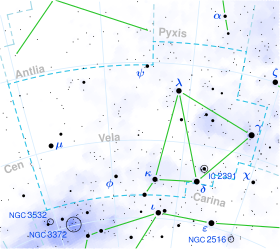무 벨로룸
Mu Velorum| 관측 데이터 에폭 J2000 이쿼녹스 J2000 | |
|---|---|
| 별자리 | 벨라 |
| 우측 상승 | 10h 46m 46.17877s[1] |
| 탈위임 | –49° 25′ 12.9244″[1] |
| 겉보기 크기(V) | 2.69[2] (2.7 + 6.4)[3] |
| 특성. | |
| 스펙트럼형 | G5III + G2V[3] |
| U-B색지수 | +0.57[2] |
| B-V색지수 | +0.90[2] |
| 아스트로메트리 | |
| 방사 속도(Rv) | +6.2km[4]/s |
| 적정운동(μ) | RA: +63.22마스[1]/yr Dec.: –54.21마스[1]/yr |
| 시차(시차) | 29.0506 ± 0.2991 마스[5] |
| 거리 | 112 ± 1 리 (34.4 ± 0.4 pc) |
| 절대치수(MV) | −0.06[6] |
| 궤도[7] | |
| 기간(P) | 138년 |
| 반주축(a) | 1.427″ |
| 편심률(e) | 0.84 |
| 기울기(i) | 57.0° |
| 노드의 경도(Ω) | 59.1° |
| 페리아스트론 에폭(T) | 1951.1 |
| 페리아스트론 인수(Ω) (2차) | 178.0° |
| 세부 사항 | |
| μ Vel A | |
| 미사 | 3.30[8] M☉ |
| 반지름 | 13[9] R☉ |
| 루미도 | 107[3] L☉ |
| 표면 중력(log g) | 2.75[8] cgs |
| 온도 | 5,047[8] K |
| 회전 속도(v sin i) | 6.4km[8]/s |
| 나이 | 360[3] myr |
| 기타 지정 | |
| 데이터베이스 참조 | |
| 심바드 | 자료 |
무 벨로룸(μ Vel, μ Velorum)은 남쪽 별자리 벨라(Vela)에 있는 이진 항성계통이다.두 별은 반주축 1.437아크초, 기간 116.24년([11]Wulff-Dieter Heintz(1986)은 궤도 원소로 138년의 기간을 표시한다.)[7]이 쌍은 겉보기 등급이 2.69이므로 [2]육안으로 쉽게 시스템을 볼 수 있다.시차 측정에서 이 시스템까지의 거리는 117광년(36파섹)으로 추정된다.[1]이 시스템은 약 3억 6천만 년 전의 것이다.[3]
1차 성분은 겉보기 규모 2.7의 거대 항성과 G5 III의 별 분류를 말한다.[3]태양 반지름의 약 13배에[9] 달하는 팽창된 대기에서 태양의 약 107배의 광도를 발산하고 있다.이 별의 질량은 태양의 3.3배이다[8].1998년 극자외선 탐사선 우주망원경은 X선 방출이 항성 전체의 출력과 거의 같은 강한 플레어를 감지했다.Mu Velorum A의 대기 X선 광도는 약 1.7 × 1030 erg이다−1.[3]
기절하는 동반자 무 벨로룸 B는 겉보기 규모 6.4의[3] 주계열성이며 G2V의 할당된 항성 분류다.[3]그러나 이 분류는 의심스럽다.스펙트럼을 자세히 살펴보면 항성이 실제로 F4V 또는 F5V의 분류를 가지고 있을 수 있으며, 이는 태양의 약 1.5배의 질량을 시사한다.그러한 별들은 일반적으로 두드러진 수준의 자기 활동을 보이지 않는다.[3]
참조
- ^ a b c d e van Leeuwen, F. (November 2007), "Validation of the new Hipparcos reduction", Astronomy and Astrophysics, 474 (2): 653–664, arXiv:0708.1752, Bibcode:2007A&A...474..653V, doi:10.1051/0004-6361:20078357, S2CID 18759600.
- ^ a b c d Johnson, H. L.; et al. (1966), "UBVRIJKL photometry of the bright stars", Communications of the Lunar and Planetary Laboratory, 4 (99): 99, Bibcode:1966CoLPL...4...99J.
- ^ a b c d e f g h i j Ayres, Thomas R.; Osten, Rachel A.; Brown, Alexander (November 1999), "The Rise and Fall of μ Velorum: A Remarkable Flare on a Yellow Giant Star Observed with the Extreme Ultraviolet Explorer", The Astrophysical Journal, 526 (1): 445–450, Bibcode:1999ApJ...526..445A, doi:10.1086/308001.
- ^ Evans, D. S. (June 20–24, 1966), "The Revision of the General Catalogue of Radial Velocities", in Batten, Alan Henry; Heard, John Frederick (eds.), Determination of Radial Velocities and their Applications, Proceedings from IAU Symposium no. 30, University of Toronto: International Astronomical Union, Bibcode:1967IAUS...30...57E.
- ^ Brown, A. G. A.; et al. (Gaia collaboration) (2021). "Gaia Early Data Release 3: Summary of the contents and survey properties". Astronomy & Astrophysics. 649: A1. arXiv:2012.01533. Bibcode:2021A&A...649A...1G. doi:10.1051/0004-6361/202039657. S2CID 227254300. 이 소스에 대한 Gaia EDR3 레코드 VizieR.
- ^ Cardini, D. (January 2005), "Mg II chromospheric radiative loss rates in cool active and quiet stars", Astronomy and Astrophysics, 430: 303–311, arXiv:astro-ph/0409683, Bibcode:2005A&A...430..303C, doi:10.1051/0004-6361:20041440, S2CID 12136256.
- ^ a b Heintz, W. D. (April 1986), "Orbits of 20 visual binaries", Astronomy and Astrophysics Supplement Series, 64 (1): 1–7, Bibcode:1986A&AS...64....1H. 루 155번으로 기재되어 있다.
- ^ a b c d e Mallik, Sushma V.; Parthasarathy, M.; Pati, A. K. (October 2003), "Lithium and rotation in F and G dwarfs and subgiants", Astronomy and Astrophysics, 409: 251–261, Bibcode:2003A&A...409..251M, doi:10.1051/0004-6361:20031084.
- ^ a b Mullan, D. J.; et al. (May 2006), "A Comparative Study of Flaring Loops in Active Stars" (PDF), The Astrophysical Journal Supplement Series, 164 (1): 173–201, Bibcode:2006ApJS..164..173M, doi:10.1086/502629, hdl:10211.3/172064.
- ^ "CCDM J10468-4925AB -- Double or multiple star", SIMBAD, Centre de Données astronomiques de Strasbourg, retrieved 2012-02-03.
- ^ Hoffleit, D.; Warren, W. H., Jr. (1987), "The Bright Star Catalogue", Astronomical Data Center Bulletin (5th revised ed.), 1 (4): 285–294, Bibcode:1987ADCBu...1..285H.



